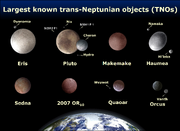
Artistic comparison of Eris, Pluto, Makemake, Haumea, Sedna, 2007 OR10, Quaoar, Orcus, and Earth. These eight trans-Neptunian objects have the brightest absolute magnitudes, although several other TNOs have been found to be physically larger than Orcus, and several more may yet be found.
|
|
‡ Trans-Neptunian dwarf planets are called "plutoids" |
A plutoid, or ice dwarf, is a trans-Neptunian dwarf planet: that is, a body orbiting beyond Neptune that is large enough to be rounded in shape. The term was adopted by the International Astronomical Union (IAU) working group Committee on Small Bodies Nomenclature, but has also been rejected by the IAU working group Planetary System Nomenclature.[1] The term is not widely used by astronomers.
There are thought to be a hundred or so plutoids in the Solar System, although only four have been formally designated as such to date.
The IAU developed this category of astronomical objects as a consequence of its 2006 resolution defining the word "planet". The IAU's formal definition of 'plutoid,' announced 11 June 2008, is:
- Plutoids are celestial bodies in orbit around the Sun at a semi-major axis greater than that of Neptune that have sufficient mass for their self-gravity to overcome rigid body forces so that they assume a hydrostatic equilibrium (near-spherical) shape, and that have not cleared the neighbourhood around their orbit. Satellites of plutoids are not plutoids themselves.[2]
Accordingly, in the language of mathematical set theory, plutoids can be thought of as the intersection of the set of dwarf planets and the set of trans-Neptunian objects.
In light of the difficulty of remotely ascertaining hydrostasis, the IAU only formally confers "dwarf planet" (and by extension, "plutoid") status to those bodies whose minimum estimated size is substantially greater than what is generally thought necessary to guarantee hydrostatic equilibrium. As of 2009[update], Pluto, Eris, Haumea, and Makemake are the only objects officially recognized as plutoids, while upwards of seventy more bodies that currently lack formal recognition are thought likely to meet the definition, and can expect formal recognition at some time in the future.[3]
Alan Stern of the Southwest Research Institute believes the outer planets show signs of collisions with plutoids 1,000 to 2,000 kilometers in diameter: Uranus could have been tipped off its axis by a plutoid, and Triton, the largest moon of Neptune, is probably a captured plutoid from the Kuiper belt.[4]
References[]
- Notes
- ↑ Karel A. van der Hucht, ed. (2009). "Reports on Astronomy 2006–2009". Transactions IAU XXVIIA. DOI:10.1017/S1743921308025398.
- ↑ Plutoid chosen as name for Solar System objects like Pluto. International Astronomical Union (News Release – IAU0804) (June 11, 2008, Paris). Retrieved on 2008-06-11.
- ↑ Brown, Michael E.. The Dwarf Planets. California Institute of Technology, Department of Geological Sciences. Retrieved on 2008-01-26.
- ↑ Craig B Agnor, Douglas P Hamilton (May 2006). "Neptune's capture of its moon Triton in a binary–planet gravitational encounter". Nature 441 (7090): 192–194. DOI:10.1038/nature04792. Retrieved on 2006-05-10.
- References